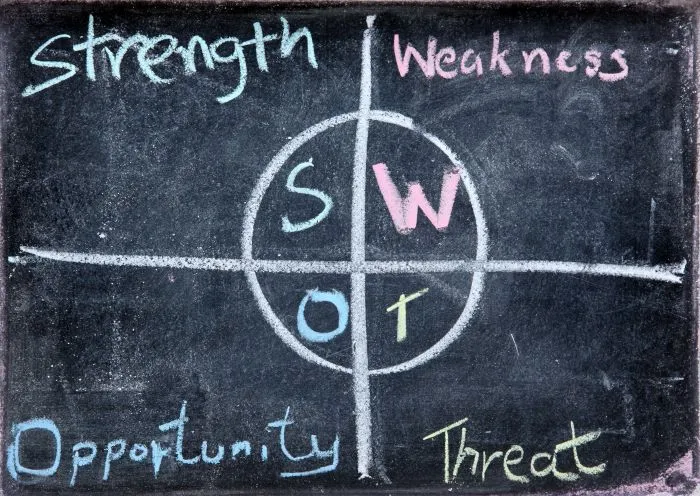SWOT analysis is usually used in planning strategies and analyzing problems in a business. Of course, this analysis can help companies overcome challenges and determine what to aim for next as a whole.
For those of you who want to be involved in the business world, make sure you know what a SWOT analysis is, its benefits, when to do it and examples.
So, instead of waiting a long time, let's just look at the complete discussion regarding the following SWOT analysis.
1. What is SWOT Analysis?
SWOT analysis is a technique or framework used to identify strengths, weaknesses, potential and risks in order to develop a business plan or strategy.
Of course, the existence of a SWOT analysis will help businesses find strategies that are most likely to be successful while preventing strategies that are detrimental.
Not only that, this analysis is also quite effective in identifying opportunities for improvement to stay in the competitors' position.
Usually, SWOT analysis is presented in the form of a chart or framework consisting of four different quadrants, where one quadrant will represent a particular component.
You need to know that the first person to use the SWOT method was Albert Humphrey from the Stanford Research Institute in the 1960s. Initially, this analysis was developed for business needs only. However, currently, SWOT analysis can be used by organizations from all sectors to help the decision-making process precisely and accurately.
Apart from that, SWOT is an acronym for Strength, Weakness, Opportunity and Threat.
For more details regarding the acronym SWOT, you can find out through the following explanation:
1.1 Strength
Strength, which means strength, can be used to explain the advantages of a business compared to competitors. For example, having a strong brand identity, lower prices and loyal customers.
Having strengths will help you understand what steps have been successful and worth maintaining for the business.
Here are some questions that you can use to describe your strengths in business, namely:
- What has the company done well?
- What features or categories does your company have to beat competitors?
- What does your target audience or consumers like about your company?
- What is unique about the company?
1.2 Weaknesses
Weakness or weakness is something that does not work optimally in the company. Starting from lack of capital, receiving lots of complaints from customers to high debt levels.
You must improve the weaknesses that occur in this company so that it can continue to compete with competitors.
There are several questions you can use to overcome weaknesses, namely:
- What are the things that cause poor performance and their causes?
- How does your company rank compared to competitors?
- What needs to be improved in the company?
- What resources are useful for improving overall company performance?
1.3 Opportunities
Opportunities or often referred to as opportunities are closely related to external factors that place a company in a profitable competitive position.
This opportunity arises after successfully identifying the company's own strengths and weaknesses. Of course, there are several things you must consider in identifying opportunities, namely:
- What kind of resources can you use to improve weaknesses?
- Are there market gaps or market gaps in the company's products or services?
- What are the company's business goals for this year?
- What do competitors have to offer and are there opportunities to apply it to your company?
1.4 Threats
Threat means a threat which is a factor with the potential to harm and cause problems for the company. This element is included in external factors because it is outside the company's own control.
There are several questions that you can use to answer threats that may arise, namely:
- What kinds of changes are worrying in the industry?
- In what areas can competitors be superior to your company?
- What new trends are going viral in the market today?
2. Factors that can influence SWOT analysis
There are several factors that can influence the process of preparing a SWOT analysis, namely:
2.1 Internal Factors
The internal factors contained in the SWOT analysis are strengths and weaknesses.
Generally, internal factors consist of:
- The experience the company has, both successful and unsuccessful experiences
- The resources the company has
- Strengths and weaknesses of the company
- Company financials
2.2 External Factors
Meanwhile, external factors include opportunities and threats, consisting of:
- Government regulations
- Culture, social politics, ideology and economy
- Ongoing events
- Technological developments
- Source of capital
- Trends
- Environment
3. Purpose of SWOT Analysis
The following are the main objectives of a SWOT analysis that are important for you to know, namely:
- Can create analyzes that are able to summarize all internal and external factors
- Identify risks and problems that the company must overcome
- Setting priorities in management
- To reduce errors that occur within the company, such as marketing, factual and management errors
- To find out realistic sales estimates based on market conditions and evaluation of the business growth potential itself
- SWOT analysis can help an organization determine whether it needs help from outside legal, marketing, management or financial professionals
- As a process for creating product development and business services
- Create and determine business strategies to increase competitiveness and business performance
- Evaluate and improve opportunities for customer service performance
- Make decisions on recruitment, promotions and other human resources.
4. Benefits of SWOT Analysis
As previously explained, SWOT analysis is very useful for companies so they can develop better. Apart from that, there are several other benefits that you can find, namely:
4.1 Can Turn Weaknesses into Strengths
SWOT analysis uses a detailed and detailed model when identifying company weaknesses. Therefore, you can easily find out weaknesses and improve them so that they become strengths for the company.
4.2 Understanding External Threats and Opportunities
Through the analysis carried out, you can identify threats and understand the opportunities that are currently open. Therefore, working employees can minimize threats and make the best use of opportunities.
Companies can determine goals from the analysis results, then conduct research and find out what fields are currently popular in the market. That way, companies can face challenges and find appropriate solutions.
4.3 Minimize the Risk of Loss
The next benefit of SWOT analysis is to minimize the risk of loss, both short and long term. For example, companies can evaluate business finances, then improve them so they don't experience financial problems, losses and other things.
4.4 To Determine Marketing Objectives
The next benefit can help you to evaluate the strengths, weaknesses, opportunities and threats faced by the company. The results of the evaluation can be used to set marketing goals that your company wants to achieve.
4.5 Helping When Making Decisions
The next benefit of SWOT analysis is that it can help you when you want to make decisions. Because, after analyzing all the strengths, threats, opportunities and weaknesses of the business, you can use all the data to obtain valid decisions.
4.6 Take into consideration when formulating a strategy
Not only used to make decisions, the results of the analysis are also useful as a consideration when developing strategies. So, after the analysis is complete, the documents will be immediately submitted to management and the technical team to immediately develop the right strategy for the company's goals.
4.7 Becoming a way to deal with competitors
Who would have thought that SWOT analysis could actually be used to face competitors. Because, when carrying out analysis, you don't only need to identify business strengths, weaknesses, opportunities and threats. However, how to take action to face competitors who operate in the same business field.
So, if you have carried out the analysis correctly, then your company can create an appropriate strategy that is superior to its competitors.
4.8 Can describe the company's condition in one analysis
Usually, making a company risk analysis requires long and detailed documentation, so it is not uncommon for many to feel bored and exhausted when reading the writing.
However, things like that can be overcome by making a SWOT analysis. With just one to several sheets of documents, you can find out the overall condition of the company.
5. When to Conduct a SWOT Analysis?
You can do a SWOT analysis when you want to do the following things:
5.1 When Starting a New Business or Project
When you want to start a new business or project, you can use a SWOT analysis to help identify the potential and challenges that will be faced.
Through the analysis carried out, you can develop appropriate strategies to achieve your goals and increase your chances of success.
5.2 When Evaluating an Existing Business or Project
Not only when starting a business, you can also do a SWOT analysis when evaluating an existing business or project. You can identify areas that need improvement and strengthening.
In addition, the results of the analysis will help you adjust your strategy to be more effective to increase the competitiveness of the business and project.
5.3 When Facing Tough Competition
SWOT analysis is also suitable for you to carry out when facing tight competition so you know the strengths and weaknesses of your competitors. That way, you can develop strategies so that your business is superior and strengthen your business position in the market.
5.4 When Making Strategic Decisions
Finally, you can also use SWOT analysis when making strategic decisions by considering various factors, including internal and external factors. Through this analysis, you can get more focused decisions and increase your chances of success.
6. How to Make a SWOT Analysis Correctly
For those of you who want to try making a SWOT analysis, you can follow the following methods.
6.1 Prepare the Data You Need
First, you have to prepare the data needed for the analysis process. As much as possible, the data you collect contains quantitative data, not just qualitative data, OK?
The aim is so that the analysis results can be in accordance with the company's needs and make it easier for the management team to find solutions to the company's own problems.
6.2 Be Objective and Realistic
Remember, when preparing a SWOT analysis, you must be objective and realistic. Try to act as an observer who has no interest in the business.
If you cannot carry out an attitude like this, then the results of the analysis will not be as you expected. Therefore, try to be more objective and realistic. It is a good idea to carry out this analysis process together with the team.
6.3 Carry out the Analysis Preparation Process with the Team
As previously mentioned, it is better to prepare a SWOT analysis together with a team. This is because the process you will go through is quite difficult, time consuming, and prone to subjectivity on the part of the preparers.
However, with the help of the team, the process of collecting data, compiling analyzes and making decisions becomes easier and faster. In fact, it can reduce the potential for subjectivity in the results of the analysis.
6.4 Provide solutions or suggestions according to the analysis results
Finally, make sure you provide solutions or suggestions according to the results of the analysis to the management or person in charge. Then, the strategy execution process based on this SWOT analysis can be immediately put into practice by the company.
7. Example of SWOT Analysis
To better understand SWOT analysis, you can look at the example below.
7.1 SWOT Analysis for Mendoan Tempe Business
The following is an example of a SWOT analysis for a tempeh mendoan business that you can see, namely:
7.1.1 Strength
- The frying process uses the best quality oil, is hygienic and is always replaced
- The ingredients for making tempe mendoan are easy to find
- There are various choices of seasonings besides soy sauce
- Made in several packages with certain price options and more content.
7.1.2 Weakness
- Price is more expensive than regular fried foods
- It doesn't last long, so it's not suitable for eating the next day or selling out of town with a delivery process that takes days.
7.1.3 Opportunity
- Not only for snacks, mendoan tempeh is suitable for eating as a side dish with rice
- Can be ordered using online delivery
- The taste is delicious and delicious, suitable for all groups, from children, young people, adults and the elderly
7.1.4 Threats
- There are many competitors who serve tempe mendoan with unique dishes
- There is increasing competition in the Mendoan tempeh business with cheaper price offers.
7.2 SWOT Analysis for Digital Marketing Business
Apart from the tempeh mendoan business, there is still one more example related to SWOT analysis for digital marketing businesses, namely:
7.2.1 Strength
- Each service has affordable rates
- HR has many years of experience in their field
- Has served dozens of digital marketing projects from large corporate clients and those who are still starting businesses
- Several human resources already have digital marketing certification which increases the level of confidence in their expertise.
7.2.2 Weakness
- Employees who work in business must be able to multitask, which causes them to burn out quickly
- Sometimes projects carried out by less experienced human resources are always completed not on time
- The existence of a fast pace culture means employees have to adapt to the latest knowledge.
7.2.3 Opportunity
- Clients can choose various digital marketing services according to their needs
- By offering affordable prices, small business owner clients can use these digital marketing services.
7.2.4 Threats
- Projects that are not completed on time reduce the client's confidence in using this service in the following year
- Competition in the digital marketing business is getting tougher because many people are interested in starting a business in the same field.
That's the information about SWOT analysis that you should know. Through this analysis, you can collect a lot of information to find out and evaluate things that need to be maintained, eliminated or improved in the business. Well, it's quite easy to make, right?
---
Take advantage of existing business opportunities, apply for financing with BPKB guarantees for motorbikes, cars or house certificates at BFI Finance! Easy and safe process, get a loan of up to 80% of the collateralized asset value if the requirements are complete. #SelaluAdaJalan with BFI Finance.






